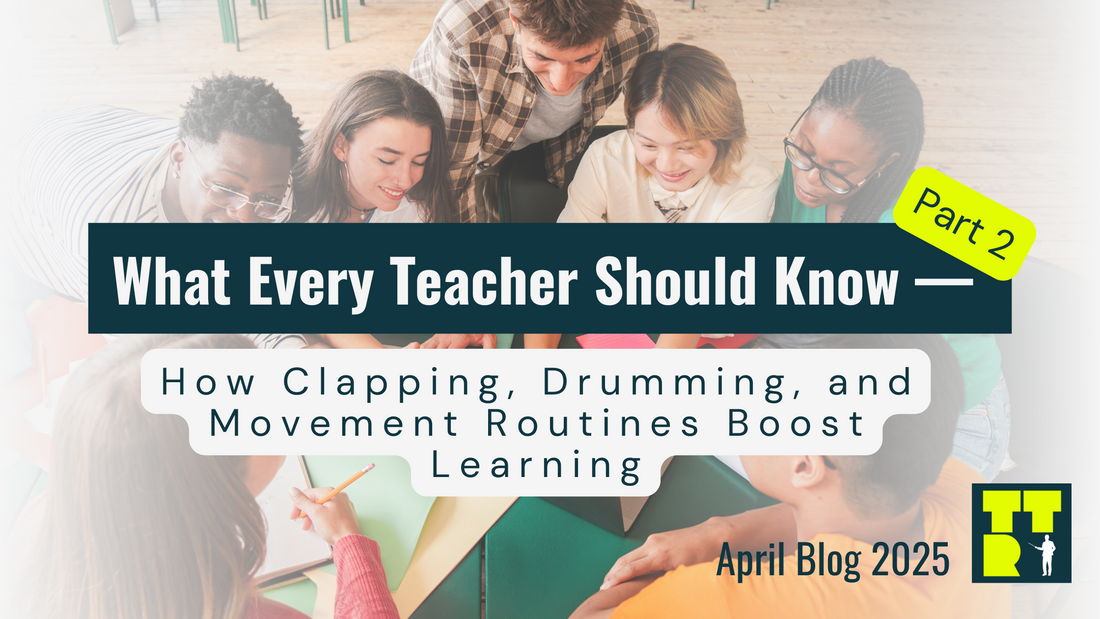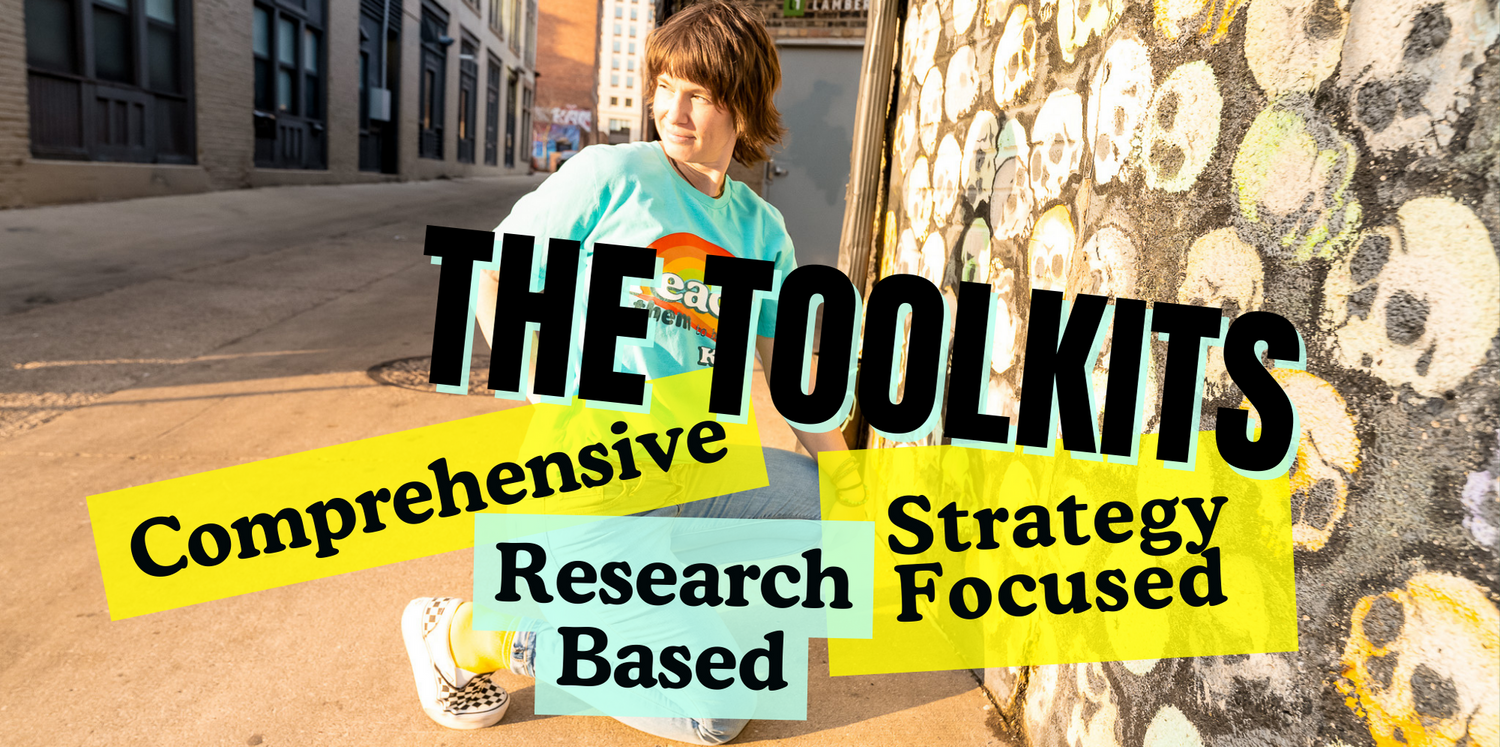
Part 2: How Clapping, Drumming, and Movement Routines Boost Learning — The Striatum in Action
Share
Why repetitive movement improves motivation, focus, behavior, and learning — and how teachers can use rhythm to support brain function.
Intro:
In Part 1 of this series, we talked about the striatum — the brain’s feedback, reward, and habit system. We explored how it helps students learn from experience, stay motivated, and turn repeated actions into automatic routines.
Now it’s time to put that knowledge into motion — literally.
There is a world where practicing a clapping pattern helps with reading. Where a stretch and stomp routine builds attention. Where dance, rhythm, and movement aren’t breaks from learning — they’re tools for learning.
And the research backs it up: repetitive, rhythmic movement strengthens the striatum. And when the striatum is working well, students are more regulated, motivated, focused, and ready to learn.
🧠 What the Research Says
Repetitive movement — like clapping, tapping, dancing, and drumming — activates multiple areas of the brain, including the dorsal striatum (for coordination and habit) and the ventral striatum (for motivation and reward). It also supports the brain’s timing system, which influences executive function, memory, and attention.
Here’s how it works in the classroom:
✔️ 1. Repetition Builds Habits and Automaticity
When students repeat a pattern — a drumming sequence, a series of hand motions, a dance routine — the striatum stores that information as a motor routine.
This is the same brain system that helps them:
-
Automate transitions
-
Remember math facts
-
Move through multi-step tasks
The more consistent and rhythmic the movement, the easier it is for the brain to encode and retrieve it.
🧠 Classroom takeaway:
Use repeated movement to build classroom routines, signal transitions, or reinforce academic content (like clapping syllables or skip-counting with jumps).
✔️ 2. Rhythm Regulates the Body and Brain
The striatum is connected to emotion regulation systems — especially those that help students manage anxiety, stress, and overstimulation.
When students engage in predictable, rhythmic activity, their nervous system begins to regulate. The brain shifts from a reactive state into a focused, safe, and receptive one.
Think of:
-
A student bouncing a ball in rhythm to stay calm
-
A class that starts each day with the same drumming pattern
-
A quiet moment where students sway or stretch to music
These aren’t distractions. They’re regulation tools that create emotional safety and help students stay engaged.
🧠 Classroom takeaway:
Use rhythmic movement when students are dysregulated, fidgety, or overwhelmed — especially before or after transitions, tests, or recess.
✔️ 3. Rhythm Supports Timing, Sequencing, and Attention
The striatum is a key part of the brain’s internal timing and sequencing system — meaning it helps students:
-
Stay in sync with instructions
-
Move from step 1 to step 2 in a task
-
Maintain attention over time
Practicing rhythmic movement strengthens this system. That’s why kids who drum, dance, or clap on beat tend to show improved working memory, task switching, and self-regulation.
🧠 Classroom takeaway:
Incorporate clapping patterns or short movement sequences into directions, transitions, or memory tasks — it will actually help students hold and process more information.
For a really great example of this and how to create habits and routines that use these strategies check out the Meet the Needs Workshop Series- Workshop 1 The Power of Habits HERE.
✔️ 4. Movement Triggers Dopamine and Motivation
Rhythmic movement — especially when students enjoy it — triggers the ventral striatum to release dopamine. This gives students a sense of reward, satisfaction, and motivation.
It also increases the chance they’ll want to repeat the activity — and the behavior associated with it. So if reading time starts with a calming stretch routine that students enjoy, the brain connects that good feeling with the learning that follows.
🧠 Classroom takeaway:
Use enjoyable movement routines as part of daily structure. This builds motivation and positive emotional association with learning.
🔁 Activities That Support Striatum Function
Here are a few low-prep, high-impact activities that help build striatum function across K–12 classrooms:
🪘 Drumming Patterns
-
Use hand drums, desk tapping, or body percussion
-
Start with call-and-response patterns (teacher leads, students echo)
-
Progress to layered group rhythms or student-led sequences
Why it works:
Repetition and rhythm build procedural memory, focus, and dopamine-based reward. Students must listen, repeat, and stay engaged in time.
✅ Use before a lesson to focus energy
✅ Use after transitions to re-center
✅ Use to teach patterning or sequencing
👏🏾 Clapping Games & Hand Rhythms
-
Echo claps (teacher claps a pattern, students copy)
-
Partner clapping games
-
Rhythmic clapping during chants or transitions
Why it works:
These activities activate motor and reward circuits, build timing, and support task switching. They also create belonging, which enhances dopamine release.
✅ Use to practice syllables, multiplication facts, or vocabulary
✅ Use as attention-getters or reset cues
✅ Use to build community and connection
💃🏽 Dance Routines or Movement Sequences
-
Simple choreographed steps (e.g., “step-touch-spin-clap”)
-
Song-based movement routines
-
Student-created movement to represent academic concepts
Why it works:
Repeating movement sequences builds memory, body awareness, and emotional regulation. Dance routines also help with sequencing and working memory.
✅ Use for transitions (e.g., beginning or end of class)
✅ Use as a creative extension of a lesson
✅ Use for embodied learning (e.g., act out the water cycle or food chain)
🧍🏽Stretch + Stomp Routines
-
Deep stretch, three stomps, deep breath
-
Cross-body tapping or light bouncing
-
Repetitive yoga or tai chi-inspired movements
Why it works:
These patterns regulate the body, lower stress, and help students refocus. The predictability is key — the striatum encodes it as a safe and effective behavior.
✅ Use to open or close lessons
✅ Use after lunch, recess, or high-stress periods
✅ Use before testing or presentations
👩🏽🏫 How to Get Started (No Music Degree Needed)
You don’t need instruments, playlists, or choreography to do this. You just need consistency, rhythm, and repetition.
Start small:
-
Pick one movement pattern you can do daily (e.g., clapping in to start a lesson)
-
Use your voice, your body, or the desks around you — no props required
-
Keep it simple, repeat often, and invite students to take ownership over time
Pro tip: If your class struggles with transitions, start using a movement-based transition routine. This helps the striatum encode “this is what we do when it’s time to shift,” making future transitions smoother.
✅ Why This Matters
Here’s what we know:
-
The striatum helps students learn through feedback, build habits, and stay motivated.
-
It thrives on repetition, feedback, and reward-based learning.
-
Repetitive movement activities — like drumming, clapping, and dancing — directly support striatal function.
-
These activities help students with focus, emotion regulation, timing, and automaticity.
-
And best of all? They’re fun, low-stakes, and highly effective across all grade levels.
This isn’t fluff. This is the brain doing what it does best — learning through pattern, rhythm, and joy.
Final Word
There is a world where students love learning, not because we make them, but because their brains are wired for it — through feedback, movement, and meaningful repetition.
You don’t have to teach neuroscience. You just have to use what we know.
Start with rhythm. Start with movement. Start with patterns your kids can feel in their bones.
The striatum will take it from there.
To learn the best way to create habits and routines in your classroom check out the Meet the Needs Workshop Series- a 4 part workshop series that shows you how the brain works when it comes to habit formation, stress regulation, and sensory processing! Check it out here: https://teachingtoariot.com/pages/meet-the-needs-workshop-series







